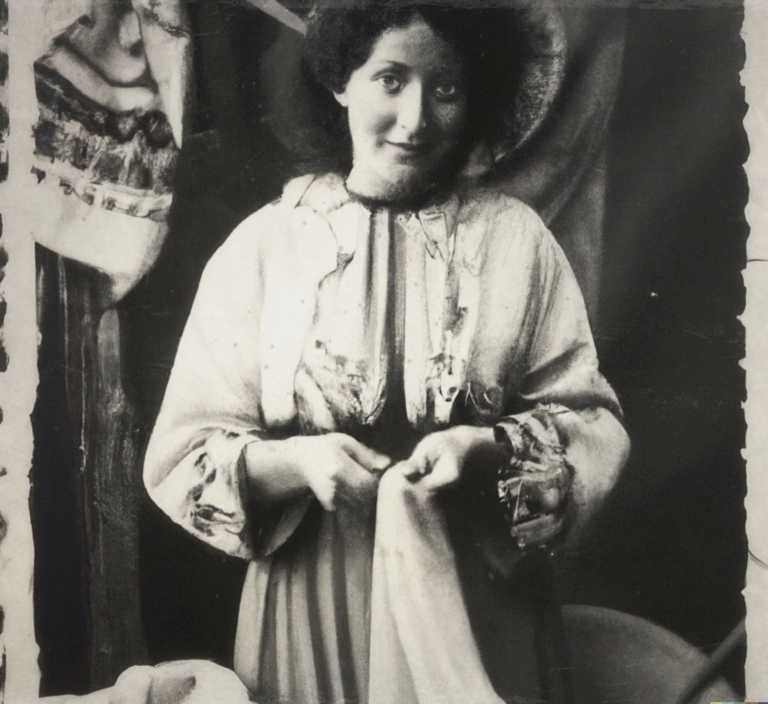
If I told you that this was a very old photograph from “ze old country” — Russia, in my family’s case — you’d believe me, right? And if I said this is Ruba Lefkowitz and the writing on the back of the photograph says circa 1910, that’s believable, too, right?
The truth is this isn’t even a photograph. It’s an idea, that’s all. Something I conjured up and produced using a neural network-based image generation model capable of generating images from textual input. In other words: AI. In this case, I used DALL’E: an artificial intelligence program created by the same mother company that now brings us ChatGPT.
Maybe the next question is easy to guess: Why? Why would I be interested in AI? Haven’t I heard it’s the end of humanity as we know it?
I’ve heard the doomsday warnings but I know so little about physics that I’m willing to take the quantum leap (get it? Quantum? Hahaha! A little gallows humor, perhaps…) and give the whole thing a try.
The process starts with an idea. Maybe it’s a specific image, but it can also be something vague. The ideas and intuitions must be expressed as written prompts. From the word(s), DALL’E (in the words of Benjamin Labatut, writer) “hallucinates” in some intended direction. It’s genuinely a bit of a crap shoot. The algorithm does what the algorithm does. Randomness and chaos inevitably creep in. And then the artist’s work begins: erasing parts, editing parts, clarifying with more words, narrowing in on the vision, selecting the most resonant images and seeing them evolve in strange and almost magical ways.
The gravity of the past lends its weight to these images.
DALL’E has been hard-coded by OpenAI to avoid the production of violent or pornographic images. Likewise, certain terms are deemed unacceptable and must be deleted before the algorithm goes to work. For example, with another image, I tried using the word Nazi because I wanted to show a particular time period (1939-1944) in European history. DALL’E said no.
That brings me around to this “photograph” of Ruba Lefkowitz from 1910. Who is she? She’s a product of my imagination. I created her, going back and forth, refining, editing, clarifying. The more important question is around what purpose she serves.
I want to capture ghosts. I want to create — or is it re-create — a world that no longer exists. It is the world my paternal grandmother was born into at the end of the 19th century (1897) in a poor shtetl in Russia. I want to create a context for MY life by creating a past story I do not hve for HERS. I am unable to go back more than two generations on my father’s side of the family. I have no idea who my grandmother’s mother or grandmother or great-grandmother were, how they lived, what they looked like. I don’t even know their names. I don’t know anything about the shtetl, the butcher, the button maker, the matchmaker, any of it. I just know my grandmother was very poor, and she lived with her sister and their stepmother, and that her father had left for America to start a new life before bringing them over. That took seven years.
In my MFA project this semester (June-Nov), I am using AI to help me create an imagined place and time. I’m populating that world with people like Ruba Lefkowitz. I am making her a neighbor or maybe a friend of my grandmother’s so that I can create a world from which my father’s mother originated. She fled, yes, because of religious persecution of Jews. But she fled something that has since disappeared, and in that disappearance is part of my story, too. With this work, I am finding the beauty of connecting with the invisible realm of the spirit.
I am creating a form of a past. A personal past. The images themselves (for they are images and not photographs) contain a degree of sadness. This is not only the sadness of an era; it is also, as Labatut notes, “a nostalgia for things that did not come to pass.”
I’m only at the beginning stages of the work. I have hundreds of images to make. Maybe more. Diving deeper and deeper into a world I kind of “know” through stories and family lore, and also a world that I do not know because it never existed in this form.
This isn’t trickery. I’m not going to say these are family photographs suddenly found in an old box in an attic of a distant cousin’s old house. I freely admit these are constructions of my imagination…collaborating with technology. I am a storyteller, after all.
In their profound otherness, these images may bring something powerful into my life: a glimpse of what might have been. Of how things were. Where my story may have begun.
Stay tuned. There will be more.
Amy, I love how you’re using AI for your semester project and I’m excited to see the body of work you produce going down this really cool rabbit hole! How exciting for you as an artist and storyteller. Bravo, my friend!
Thank you, Beth!